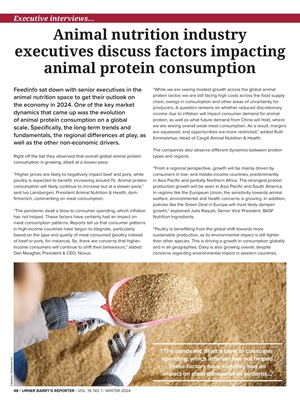
48 • URNER BARRY'S REPORTER / VOL. 19, NO. 1 / WINTER 2024
"While we are seeing modest growth across the global animal
protein sector, we are still facing high costs across the food supply
chain, swings in consumption and other areas of uncertainty for
producers. A question remains on whether reduced discretionary
income due to inflation will impact consumer demand for animal
protein, as well as what future demand from China will hold, where
we are seeing overall weak meat consumption. As a result, margins
are squeezed, and opportunities are more restricted," added Ruth
Kimmelshue, Head of Cargill Animal Nutrition & Health.
The companies also observe different dynamics between protein
types and regions.
"From a regional perspective, growth will be mainly driven by
consumers in low- and middle-income countries, predominantly
in Asia Pacific and partially Northern Africa. The strongest protein
production growth will be seen in Asia Pacific and South America.
In regions like the European Union, the sensitivity towards animal
welfare, environmental and health concerns is growing. In addition,
policies like the Green Deal in Europe will most likely dampen
growth," explained Julia Raquet, Senior Vice President, BASF
Nutrition Ingredients.
"Poultry is benefitting from the global shift towards more
sustainable production, as its environmental impact is still lighter
than other species. This is driving a growth in consumption globally
and in all geographies. Dairy is also growing overall, despite
concerns regarding environmental impact in western countries,
Feedinfo sat down with senior executives in the
animal nutrition space to get their outlook on
the economy in 2024. One of the key market
dynamics that came up was the evolution
of animal protein consumption on a global
scale. Specifically, the long-term trends and
fundamentals, the regional differences at play, as
well as the other non-economic drivers.
Right off the bat they observed that overall global animal protein
consumption is growing, albeit at a slower pace.
"Higher prices are likely to negatively impact beef and pork, while
poultry is expected to benefit, increasing around 1%. Animal protein
consumption will likely continue to increase but at a slower pace,"
said Ivo Lansbergen, President Animal Nutrition & Health, dsmfirmenich, commenting on meat consumption.
"The pandemic dealt a blow to consumer spending, which inflation
has not helped. These factors have certainly had an impact on
meat consumption patterns. Reports tell us that consumer patterns
in high-income countries have begun to stagnate, particularly
based on the type and quality of meat consumed (poultry instead
of beef or pork, for instance). So, there are concerns that higherincome consumers will continue to shift their behaviours,"
added
Dan Meagher, President & CEO, Novus.
Executive interviews…
Animal nutrition industry
executives discuss factors impacting
animal protein consumption
"The pandemic dealt a blow to consumer
spending, which inflation has not helped.
These factors have certainly had an
impact on meat consumption patterns…"
©BearFotos / Shutterstock.com